Clash of Titans
Games featuring a future Hall of Fame coach on each sideline.
On October 11, 1924, LSU played its first game against a school from the Western Conference (forerunner of the Big Ten). Second-year coach Mike Donahue's Tigers traveled 24 hours by train to Indianapolis to play the Indiana Hoosiers.
The day of the game was proclaimed "Dixie Day" in Indy, and a crowd of 12,000 filled the baseball field stands "to see Indiana take the Tigers like 'Grant took Richmond'" (to quote the impassioned prose of LSU's 1924 Yearbook). Almost all were Hoosier faithful except for the LSU Cadet Band that had traveled with the team. Back home, Tiger rooters gathered at State Field (precursor of Tiger Stadium) to follow the action by wireless on the GridGraph mounted on a stage and narrated by "Wild Bill" Graham.
Bill Ingram, in his second season as Indiana coach, played at Navy from 1916 to 1918. He began his coaching career at William & Mary in 1922, where he compiled a 6-3 record before moving to his native state.
"Beneath a summer sun which brought memories of Louisiana home to the men," the Tigers started badly when Ike Carriere fumbled a punt, and Daniel Bernoske, Indiana's "speedy lineman," picked up the ball and ran for a touchdown.
LSU responded with a 60y touchdown drive of their own using their "celebrated 'Line Divide' formation." Allen Connell's 15y scoring run that should have tied the score, but the PAT failed. Indiana 7 LSU 6
In his book The Fighting Tigers II, Peter Finney described Donahue's signature offensive formation this way:
Donahue's "line-divide" baffled the opposition for years (Auburn was using it in 1910) before the enemy learned to concentrate four or five good linemen in front of the "I" made by two halfbacks, the fullback, and the quarterback, who lined up Indian file behind the center. On "line-divide-right" there was an end and a guard to the left of the center. Immediately to the center's right there was a gap of three and a half yards. In this gap, just off the line of scrimmage, were the two tackles. To their right, on the line, was a guard and an end. On the shift, both tackles moved into the line, leaving a split of some two yards. In the backfield, the quarterback would shift to a spot just behind the gap between the tackles; the right half, to a wingback spot; the fullback, to a spot behind the quarterback; the left half, to a tailback's spot. All signals were called by the quarterback, the numbers designating the players and where they were to go.
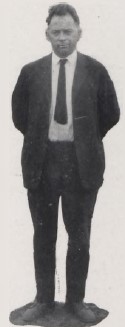

L: Coach Mike Donahue; R: LSU's "Line Divide" offense attacks the Indiana defense.
(LSU Gumbo Yearbook Class of 1925)
Poor Punt Gives Hoosiers Great Field Position
The Hoosiers extended their lead thanks to an advantageous punt exchange. After Lawrence Marks punted to the LSU 3, the Tigers ran one play and punted. But William Pitcher's boot traveled only 18y, going out of bounds on the LSU 21. Four straight running plays culminated in Max Lorber plunging into the end zone. Indiana 14 LSU 6
Tigers Capitalize on Fumble
The Tigers took advantage of a break in the third quarter when Oliver "Ike" Carriere ("the game little quarterback and lightest man on the team") made amends for his earlier bobble that set up Indiana's first touchdown by recovering a fumble on the Indiana 42.
Two plays later, junior HB Norman Stevens burst 38y to pull LSU within one as hats flew and cheers erupted 850 miles away in Baton Rouge.
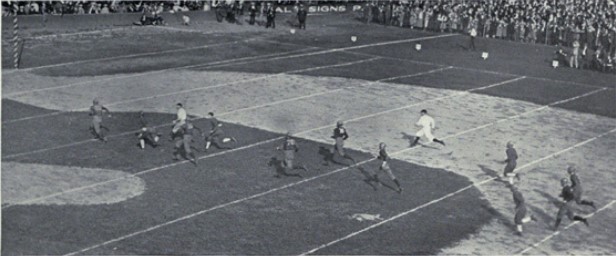
Norm Stevens runs for LSU touchdown.
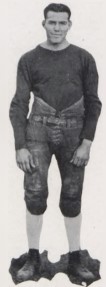
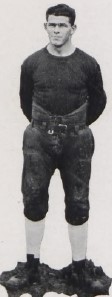

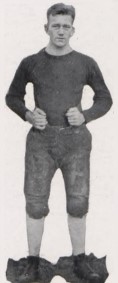
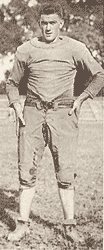
L-R: Ike Carriere, Gus Jackson, Norman Stevens, Ben Miller, Opie Dimmick
(LSU Gumbo Yearbook Class of 1925)
More exultation back home when LSU methodically drove 67y in the final period to score on a short run by Gus Jackson for a 20-14 lead.
LSU Stages Goal-line Stand
However, IU roared back, opening up a desperate pass attack. Victor Salmi connected with Frank Sibley for 25y and threw another pass to Templeton Smith for 11. Salmi then called his own number for 10y and a first down on the 12. Smith got three over left tackle before Salmi gained four and then two at the same spot for a first down at the two.
Salmi carried again. No gain. Smith rammed center. No gain. Salmi took another turn through the center. No gain. Donahue sent in several substitutes. IU captain Joe Sloate took the ball on fourth down, but junior E Ben Miller broke through to nail the ball carrier on the five. LSU ball!
After Charles Forgey gained 4y, Carriere asked Miller to punt the ball out of danger. He booted his first collegiate punt to midfield and then made the tackle just before time ran out.
The victory removed the goat horns from LSU QB Opie Dimmick. In the third quarter, upon intercepting a pass, he paused to yell to the stands "Bound for Dixie!" The delay allowed him to be overtaken on the IU six and cost LSU a touchdown.
The Indiana 1925 yearbook summarized the game like this:
Louisiana's tough crew, masquerading under the docile and mild name of "Pelicans," came back in the final quarter of the intersectional game at Washington Park to win a heart-breaker 20-14. Three thousand frantic Crimson rooters, urging the team on to a comeback that failed but one yard from the Louisiana goal in the last minutes of play, sorrowfully heard the gun end sixth minutes of the strongest offensive play they ever had seen.
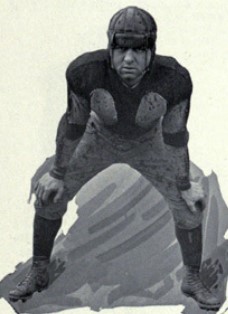
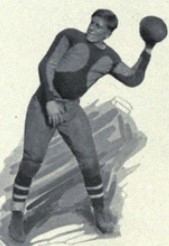
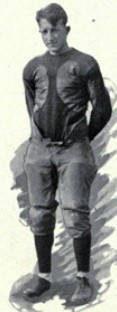
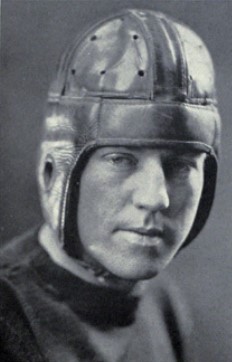
L-R: Max Lorber, Victor Salmi, Templeton Smith, Joe Sloate
(Indiana University Arbutus Yearbook Class of 1925)